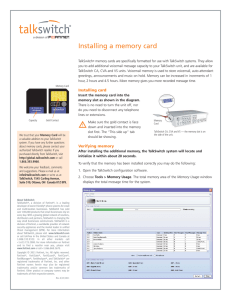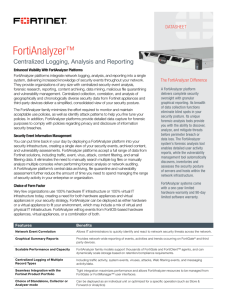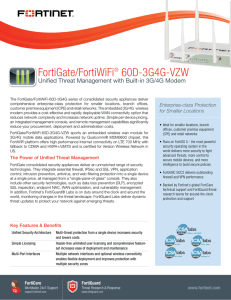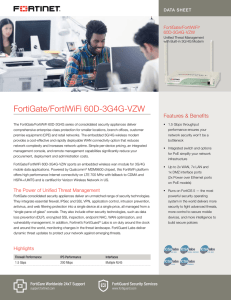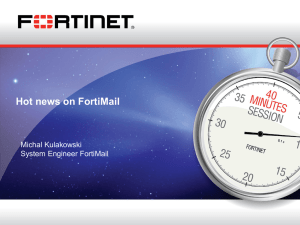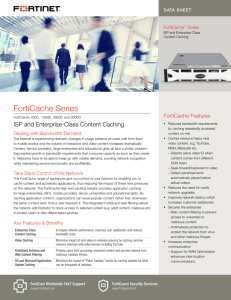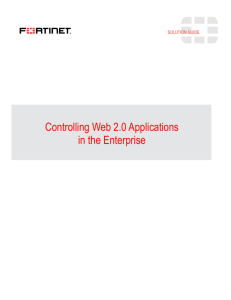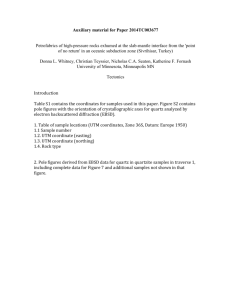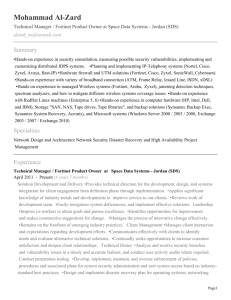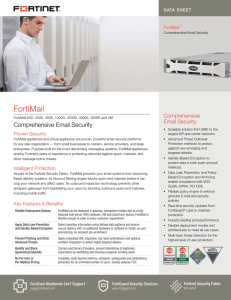Fortinet case study template
advertisement
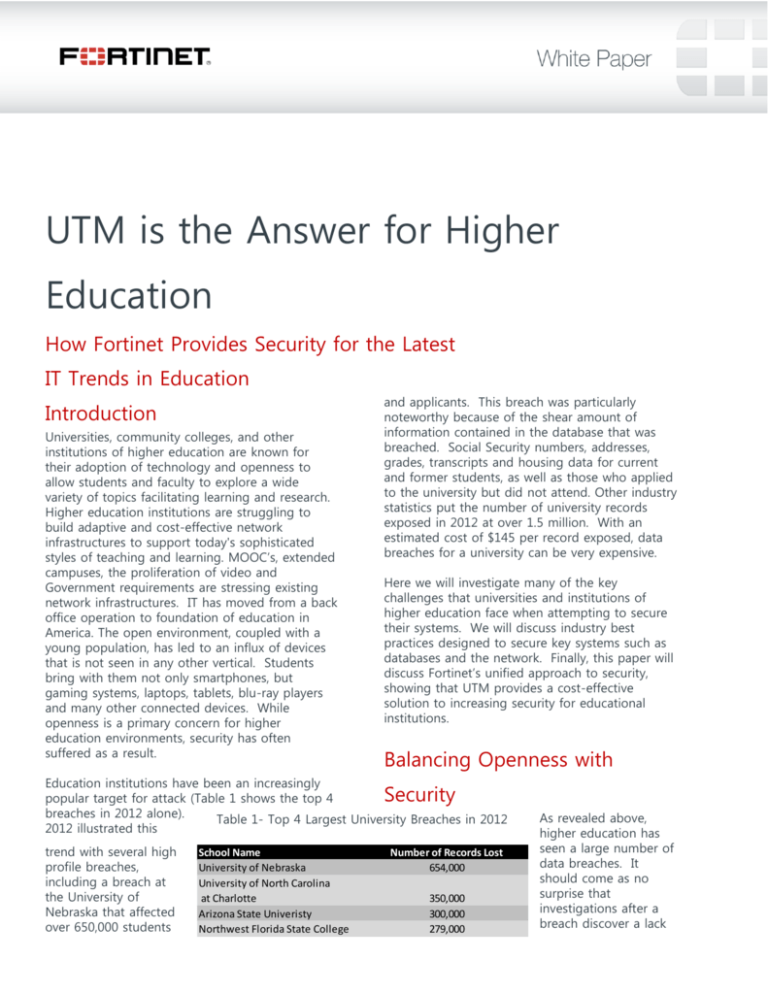
UTM is the Answer for Higher Education How Fortinet Provides Security for the Latest IT Trends in Education Introduction Universities, community colleges, and other institutions of higher education are known for their adoption of technology and openness to allow students and faculty to explore a wide variety of topics facilitating learning and research. Higher education institutions are struggling to build adaptive and cost-effective network infrastructures to support today's sophisticated styles of teaching and learning. MOOC’s, extended campuses, the proliferation of video and Government requirements are stressing existing network infrastructures. IT has moved from a back office operation to foundation of education in America. The open environment, coupled with a young population, has led to an influx of devices that is not seen in any other vertical. Students bring with them not only smartphones, but gaming systems, laptops, tablets, blu-ray players and many other connected devices. While openness is a primary concern for higher education environments, security has often suffered as a result. and applicants. This breach was particularly noteworthy because of the shear amount of information contained in the database that was breached. Social Security numbers, addresses, grades, transcripts and housing data for current and former students, as well as those who applied to the university but did not attend. Other industry statistics put the number of university records exposed in 2012 at over 1.5 million. With an estimated cost of $145 per record exposed, data breaches for a university can be very expensive. Here we will investigate many of the key challenges that universities and institutions of higher education face when attempting to secure their systems. We will discuss industry best practices designed to secure key systems such as databases and the network. Finally, this paper will discuss Fortinet’s unified approach to security, showing that UTM provides a cost-effective solution to increasing security for educational institutions. Balancing Openness with Education institutions have been an increasingly popular target for attack (Table 1 shows the top 4 breaches in 2012 alone). Table 1- Top 4 Largest University Breaches in 2012 2012 illustrated this Security trend with several high profile breaches, including a breach at the University of Nebraska that affected over 650,000 students School Name University of Nebraska University of North Carolina at Charlotte Arizona State Univeristy Northwest Florida State College Number of Records Lost 654,000 350,000 300,000 279,000 As revealed above, higher education has seen a large number of data breaches. It should come as no surprise that investigations after a breach discover a lack UTM is the Answer for Higher Education | FORTINET White Paper of security controls. Institutions of higher education have a great deal of data to protect but often lack the staff and resources of similar corporate environments. This gives higher education a variety of challenges to maintaining a secure environment while keeping very open networks. Some of these challenges are listed below: Providing Secure BYOD Enterprises have seen a surge in devices as line workers bring in their own smartphones and tablets, but higher education has to contend with more devices per user and larger populations than most enterprises. Many higher education IT departments see two to three devices per students in addition to a wireless enabled laptop computer. These devices typically include smartphones and tablets, but eReaders and gaming systems also factor into the equation. Since higher education does not own any of the student devices (and doesn’t have much influence on the faculty either) supporting and securing a wide range of devices without having the ability to install software is key. An additional concern is bandwidth management. There are going to be peak usage times at a higher education institution and without bandwidth management, electronic learning, and core services such as registration and payment could be affected and overwhelmed by overwhelming amounts of traffic. In addition, BYOD brings a different format: Small packets and lots of them. Protection against the Latest Threats Another challenge faced by higher education is protecting against the latest threats. Unlike a traditional enterprise environment where there is a set list of software, and very limited access, higher education has faculty, contractors, visitors, and students using a broad range of software systems. The challenge is to ensure that malware does not have a chance to spread in the higher education network. Traditional antivirus solutions cannot keep up with modern threat landscape. Higher education needs security solutions that protect against multiple attack vectors – preventing attacks that combine zero day vulnerabilities, web exploits, Bot-Nets, and phishing attacks. Keeping Total Cost of Ownership Low Like many traditional enterprises, higher education is under resource constraints. Information security departments – if they exist at all – are understaffed. Like other verticals, the primary goals of higher education are focused on providing IT services first, security is usually added on later. Many higher education institutions also face the challenge of supporting multiple security products, which have proliferated over time. UTM + Threat Research is the Answer for Education Unified Threat Management (UTM) is not a new concept. There have been a number of UTM vendors around for years. The difference is that some vendors have continued to drive improvements in their products to address the challenges and scale required by the largest organizations. Today, UTM allows organizations of any size to combine a wide variety of core security solutions into a single device, allowing even the largest higher education institutions the ability to centrally manage all their security needs from a single platform. The Threats are Quickly Evolving Security is a constant cat and mouse game between hackers and vendors. The traditional model of network security was focused on protecting the network from the outside using firewalls and other traditional security devices. With the popularity of social media applications like Facebook and Twitter and the requirement to provide easy access to data to students and staff, the potential for an accidental malware incident increases significantly. All it takes is a single click and malware can then exploit vulnerabilities in applications and download malicious programs, such as key loggers, to steal user names and passwords and private data. Unfortunately, the most common applications and file formats are the ones with the greatest chance of exploit. Traditional approach of separate devices for different problems is not effective. Security requires a layered approach and only a UTM with an active threat research arm can seamlessly provide that kind of advanced security. www.fortinet.com UTM is the Answer for Higher Education | FORTINET White Paper Multiple Vendors Does Not Equal Better Security There has been a long standing thought in security that a collection of devices from various “best of breed” vendors is more effective than a unified solution. Unfortunately, practice shows that a mix of devices from multiple vendors may actually leave gaps in the security of an organization, increasing the risk of attack. There are other challenges associated with a mix of devices from different vendors. Each vendor will require its own maintenance fees and the staff must learn interfaces for each different product. Training costs are higher and the on boarding process for any new employee is longer with a mix of products. Unified Management is Fortinet is the only vendor that provides all of these capabilities. Fortinet provides Secure, End-to-End Security for Organizations of all Sizes As education organizations extend access to students with tablets and a wide variety of other devices. Fortinet has several products that can ensure secure access control through rogue AP detection, authentication, guest Wi-Fi, web filtering, rate limiting and load balancing. The two key products for providing complete, end-to-end protection are listed below. FortiGate® Fortinet’s flagship network security solution that delivers the broadest range of consolidated network security and network services on the Key market, including: firewall, VPN, traffic shaping, IPS, antimalware, application control, Data Loss Prevention, vulnerability management and many more security functions all centered on a single platform. Figure 1 illustrates the advantage of moving from a mixed architecture to a FortiGate driven Figure 1 - The Fortinet Consolidated Approach to platform. Security The only way risks can be reduced is through monitoring of the entire system for threats. With UTM, all the traffic is passing through the same platform, giving administrators a “single pane of glass” for all the traffic on the network. This also allows administrators to set a single security policy that permeates the entire network infrastructure – ensuring that all devices on the network, wired and wireless, are protected all the time regardless of location. How Fortinet Protects Higher Education Institutions while Lowering Costs As shown above, UTM is the most effective way for higher education institutions to manage the latest security threats while lowering costs significantly. In order to address all the challenges listed above, a vendor must be selected that provides end-to-end wired and wireless security policies, centralized logging and management, and have advanced threat research capabilities to keep institutions protected ahead of the latest threat. FortiAP Wireless access point FortiAP solutions provide increased visibility and policy enforcement capabilities while simplifying your overall network environment. They employ the latest 802.11nbased wireless chip technology, offering highperformance wireless access point with integrated wireless monitoring and support for multiple virtual APs on each radio. FortiAPs work in conjunction with the feature-rich family of FortiGate controllers to provide a fortified wireless space that delivers complete content protection. FortiGate controllers centrally manage radio operation, channel assignment, and transmit power, which further simplifies your deployment and management requirement www.fortinet.com UTM is the Answer for Higher Education | FORTINET White Paper Fortinet Provides Single Pane of Glass Management Given the widely distributed nature of higher education campuses, the ability to quickly modify and manage security appliances is essential. Fortinet provides FortiManager and FortiAnalyzer products to help educational organizations manage their distributed environments. FortiManager ™ “Single pane of glass” management console for configuring and managing any number of Fortinet devices, from several to thousands, including FortiGate®, FortiWiFi™, FortiMail™ and FortiAnalyzer™ appliances and virtual appliances, as well as FortiClient™ endpoint security agents. You can further simplify control and management of large deployments by grouping devices and agents into administrative domains (ADOMs). FortiAnalyzer ™ Centralized logging, analyzing, and reporting appliances securely aggregates log data from Fortinet devices and other syslog-compatible devices. A comprehensive suite of easily customized reports enables you to analyze, report, and archive security event, network traffic, Web content, and messaging data to measure policy compliance. Fortinet Provides Protection against the Latest Threats through FortiGuard Labs The FortiGuard Network has data centers around the world located in secure, high availability locations that automatically deliver updates to the Fortinet security platforms. With the FortiGuard Subscription Services enabled, customers can rest assured that their Fortinet security platforms are performing optimally and protecting their corporate assets with the latest security technology The FortiGuard security team continually develops new attack filters to address the latest vulnerabilities and incorporates these filters into security signatures. Signatures are created not only to address specific exploits, but also potential attack permutations, protecting customers from zero-day threats. Fortinet deploys a variety of security filters for a variety of products including traffic anomaly filters, vulnerability-based filters, and signatures. Signatures are delivered to customers on a regular basis – twice a day for IPS, four times a day for antivirus, and automatically for antispam and web threats, with no user interaction required. This constant updating against both the most prevalent and unexploited threats provide significant protection to Fortinet customers. Conclusion Higher education will continue to be at the forefront of technology driven learning. This is inevitable given the combination of new, young students and cutting research that occur in higher education. The challenge for these institutions is to provide a IT platform that enables flexible connectivity while providing security for sensitive student data. Having one platform that provides the same security and connectivity is even more desirable, as universities and other higher education organizations face budgetary pressures. Fortinet provides both the flexibility and security for any higher education institution to control access – segregating sensitive and non-sensitive data, and doing it all with fewer resources. Fortinet’s breadth of products, constant security updates and overall lowered TCO allows higher education organizations the ability to securely deliver cutting edge IT services to students, faculty, and staff while ensuring that all information stays secure. www.fortinet.com
